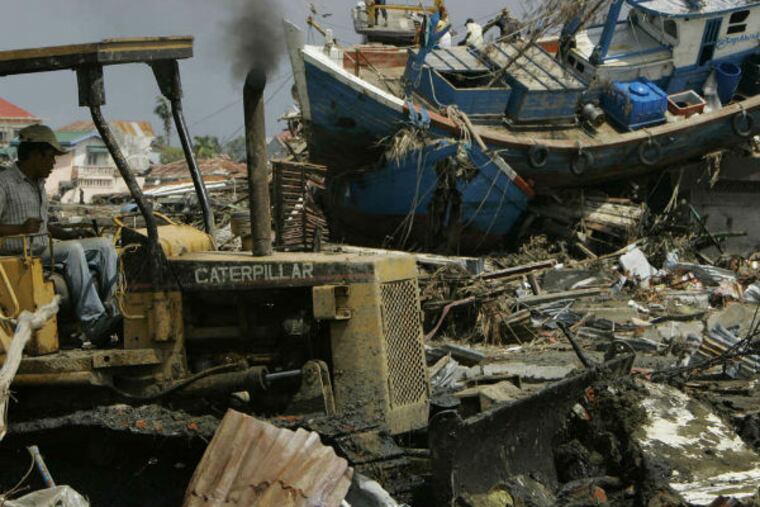Signs of recovery 10 years after tsunami
By Elizabeth Frankenberg and Duncan Thomas On a sunny morning on the west coast of Aceh, Indonesia, mothers chat near a calm blue sea as children play nearby. It is almost unbelievable that 10 years ago, on Dec. 26, 2004, 60-foot-high waves surged through this village and many others, decimating everything in their path and leaving about 170,000 people dead.

By Elizabeth Frankenberg
and Duncan Thomas
On a sunny morning on the west coast of Aceh, Indonesia, mothers chat near a calm blue sea as children play nearby. It is almost unbelievable that 10 years ago, on Dec. 26, 2004, 60-foot-high waves surged through this village and many others, decimating everything in their path and leaving about 170,000 people dead.
After the tsunami, the Indonesian government, donors, nongovernmental organizations, and individuals contributed roughly $7 billion in aid for Aceh, and the government established a high-level bureau based there to coordinate recovery. What did these resources buy? The answer matters for anyone who wonders whether assistance can make a lasting difference for people struck by a natural disaster.
In the first year, progress in Aceh was slow and frustration was high. But 10 years on, a very different picture has emerged. In many respects, life has returned to something that feels normal. It's a recovery in which Aceh, the Indonesian nation, and the world should take pride - but it did not come quickly, easily, or cheaply.
We lead an international team of scientists for the Study of the Tsunami Aftermath and Recovery (STAR). Beginning five months after the disaster, we searched for 32,320 people first interviewed as part of a 2004 survey in nearly 500 communities along the Indonesian coast. Of the 30,000 survivors, we interviewed 96 percent in follow-up surveys between 2005 and 2010, measuring the immediate impact of the tsunami and subsequent recovery in badly damaged communities in comparison with communities not directly affected.
The tsunami was devastating, tearing apart networks of family, friends, and neighbors. In some communities, 80 percent of the population perished. The tsunami destroyed homes and livelihoods. In the immediate aftermath, survivors focused on finding food, water, and shelter. Within four months, nearly two-thirds of those in severely damaged communities had moved away.
It took time to establish property rights and assemble construction materials, but within five years, residents lived in family-owned homes at the same rates as before the tsunami. They formed new families through marriage. In communities where tsunami mortality was higher, we saw a greater fertility increase in the five years after the tsunami. Recently married couples had their first babies, and mothers whose children had been killed gave birth again.
Some women were pregnant when the tsunami struck, and their needs were particularly acute. Two years after the tsunami, children in utero at the time of the tsunami were shorter for their age than Acehnese children born before the tsunami, probably reflecting their mothers' stress and reduced resources. But within three years, in terms of height by age, most of these children had caught up to or even surpassed their older counterparts. Post-tsunami assistance provided a health advantage that may turn out to be permanent.
Not everyone recovered to the same degree. The loss of one or both parents took a toll on children ages 15 to 17. Five years after the tsunami, boys who lost parents left school and entered the workforce at higher rates than boys whose parents survived. Older girls who lost both parents married sooner. In contrast, schooling outcomes did not differ among younger children, although gaps may emerge. Among adults, a man whose wife died was much more likely to remarry than a woman whose husband died.
Major shifts in the composition of the labor force accompanied reconstruction. Among adults from heavily damaged communities, the proportion of young men and young and middle-aged women working increased, but employment rates declined markedly for middle-aged men and modestly for older men and women (relative to rates for individuals of the same age from other areas).
Aceh's experience of disaster was extreme but not unique. The tsunami affected many other countries around the Indian Ocean. Over the last decade, hurricanes, earthquakes, and tsunamis have struck the United States, Pakistan, China, Myanmar, the Philippines, and Japan, taking enormous tolls on people and livelihoods and straining public and private safety nets.
As we mark the 10th anniversary of the 2004 tsunami, Aceh's example is striking. The disaster was horrific, but the hard work and perseverance of families and communities - combined with the commitment of the provincial and national governments and the generosity of the international community - have helped Aceh recover to a degree simply unimaginable in the months after the disaster. When the next natural disaster strikes, Aceh provides a compelling reminder that recovery efforts really can make a lasting difference.